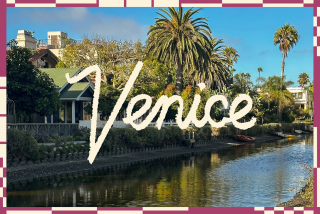Hidden Venice: The First Jewish Ghetto
- Share via
VENICE, Italy — It is a bright Venetian morning and a young guide strolling purposefully through medieval streets is followed by 15 Italian tourists who are excited and perplexed by what he has shown them.
“Why did people discriminate against Jews in the first place?” asks one woman.
“Because they killed Christ,” says a second.
“But that was a Roman proceeding. The whole thing was done by the Romans. Isn’t that right?” a third demands of the guide.
His hand turning a key in the door of an ancient synagogue, the guide replies diplomatically: “Perhaps it would be best to talk with a rabbi.”
Four centuries after it was spawned by religious hatred, the Ghetto di Venezia, the world’s first Jewish ghetto, is maturing as an educational and ecumenical treat for visitors who seek more in Venice than gondolas and gewgaws.
Venice’s Jewish community itself is being sapped by the attritions of age, but its history and surprising monuments are brighter and easier to explore than ever.
Restorations financed by national, regional and local Italian governments, plus private money from abroad, have brought new life to the two islands where Jews lived and worked in enforced isolation from 1516 until 1797. This year, the working class, off-the-beaten-track Venetian neighborhood where tourists were seldom seen a decade ago will attract nearly 50,000 visitors.
The ghetto, which takes its name from a 14th-Century cannon foundry or “geto” on the site where the community was founded, is centered around a big open piazza, far from St. Mark’s Square, northeast of the train station, Stazione Ferroviaria. In this piazza moneylenders and pawnbrokers once manned stalls or “banks.”
Shakespeare’s Shylock was a fictional resident of a ghetto where Jews lived crammed in seven-story tenements flanking the piazza.
Since Jews were prohibited from living elsewhere, as their numbers grew to a 17th-Century high of around 5,000, so did their apartment houses. Today, they are the tallest private dwellings in Venice.
At one corner of the piazza is a pensioners’ home where about two dozen of Venice’s remaining 550 Jews live with community support. Next to it are bronze panels by an American artist that recall 200 Venetians who were among the 8,000 Italian Jews who died in the Holocaust.
Across the piazza is a Jewish community center and a new library for old books and new--including a 500-page history of the ghetto by Venetian Jew Riccardo Calimani that is now in its seventh printing.
The earliest residents of the ghetto, guides tell visitors, were Yiddish-speaking, Ashkenazi Jews from Germany and elsewhere in northern Europe. They built three ornate synagogues overlooking the big cobblestone piazza.
Dark, narrow indoor passageways wound through the tenements to the houses of worship. Restoration began at the beginning of April on a 1500s apartment in one of the tenements aimed at showing visitors how ghetto families lived.
The Ashkenazi synagogues, all located on second and third stories of buildings that were also used for shops and dwellings, can be recognized from the piazza by five vaulted windows in a row.
A visit to them begins at the ghetto museum, which was recently restored and contains an intriguing collection of antique silver religious artifacts, finely worked prayer shawls and historic community documents such as the illuminated 1837 Hebrew marriage contract of Elia Vivante and Fanny Sforni of Mantua.
Upstairs in the museum building, visitors see the German synagogue, where gilt-lettered Ten Commandments in Hebrew circle the dark walls. This, the first of the Venetian synagogues, was built in 1528 and expanded in the 17th Century to include an enclosed balcony for women worshipers.
Nearby, restoration has just been completed on the top-floor, one-room Canton synagogue (“canton” meant corner in Medieval Venetian) which, visitors are told, is the only synagogue in Europe decorated with paintings.
Small insets in the dark, wood-panelled walls depict Jerusalem, the Red Sea, Sodom and Gomorrah and the arrival of manna from heaven.
The Canton, completed in 1531, is also embellished with a panel of stained glass from nearby Murano, its five windows facing a canal that marked the old ghetto boundary.
What is called the Italian synagogue, the third facing the ghetto square, is restored, but not currently open to visitors.
In the 1540s, the Venetian ghetto felt the impact of the expulsion of Sephardic Jews from Spain a half century before. So-called “Marranos” came to Venice in two waves; from Constantinople and from Portugal. To accommodate them, the ghetto was expanded to part of an adjoining island.
Amid sometimes nasty relations with earlier settlers, the Spanish newcomers quickly became a majority in the ghetto. On their island they built two synagogues: the Spanish, which is the largest and boasts an unlikely organ, and the Levantine, which is heated and used for winter services by the modern Jewish community.
After centuries of misery, the Jews of Venice started toward emancipation when Napoleon conquered the Venetian Republic in 1797 and flung open the doors of the ghetto.
“That day every Jew with 10 lire in his pocket set off to find himself someplace else in Venice to live,” says Roberto Bassi, president of the Jewish community.
Today, only a handful of Jewish families still live along the old ghetto streets, but the spirit of their forefathers survives in the candelabra-lit old synagogues; evocative and moving. For a visitor, Venice’s ghetto is easier to find than to forget.
More to Read
Sign up for The Wild
We’ll help you find the best places to hike, bike and run, as well as the perfect silent spots for meditation and yoga.
You may occasionally receive promotional content from the Los Angeles Times.






